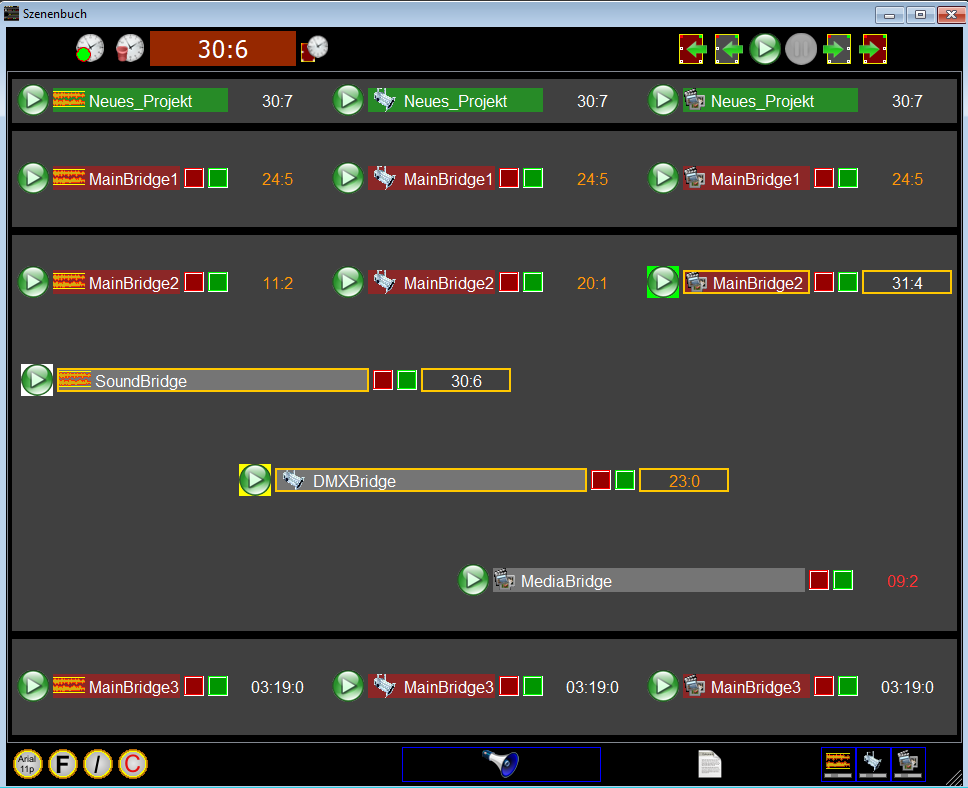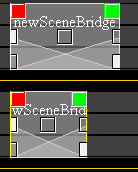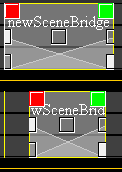
All scene transitions (see Timeline) are shown here in their order.
You can start or stop scenes directly.
The time display and the playback control
The representation of the scene transitions (sound-light-media scene transitions)
Show Control
The display of active scene transitions
Entering stage instructions
HTML Export
Open the settings of a scene transition
The representation of jumps (loops)
Automatic scrolling
The time display and the play buttons correspond to those described in the play control.
The recording of the times is also described in the play control.
The representation of the scene transitions (sound-light-media scene transitions)
Show Control
The display of active scene transitions
Entering stage instructions
HTML Export
Open the settings of a scene transition
The representation of jumps (loops)
Automatic scrolling
The time display and the play buttons correspond to those described in the play control.
The recording of the times is also described in the play control.
The representation of the scene transitions (sound-light-media scene transitions)

The scene transitions (scene bridges) are displayed with their type name and the properties "Stop" and "Active", a play button and the time until the next scene transition.
The main scene transitions are shown with red and sound, light or media scene transitions with a gray background.
 |
The 'Stop' property of the scene transition is displayed and can be changed by clicking on it. Filled: The PlayCursor will stop at the beginning of the scene transition Not Filled: The PlayCursor will not stop and enter the scene transition |
 |
The 'active' property of the scene transition is displayed and can be changed by clicking on it. Filled: The scene transition is active and can be played back Not Filled: The scene transition is inactive and is skipped (the next active scene transition is played) Main scene transitions are skipped, the next main scene transition is played, all intermediate (normal) scene transitions are skipped. |
| The icons indicate whether it is a sound, light or media scene transition | |
| Click on If the scene is being played, the icon changes to  , the icon can still be clicked and the scene
transition can be played again. , the icon can still be clicked and the scene
transition can be played again.In the case of main scene transitions (shown in red), the sound, light and media scene transitions are started. The icon react when the left mouse button is released. If you pressed the mouse button on the icon and want to cancel the action, move the mouse (with the mouse button pressed) far away from the icon and then release the mouse button. |
|
 |
Double-clicking on the name of a scene transition opens the Object Properties window of the scene transition. Here you can set the name, jumps, etc. However, you should pay attention when changing the length to check the object arrangement in the timeline again. For main scene transitions (shown in red), you must adjust the changes to fade times and jumps for the sound, light, and media scene transition. Reminder: Main scenes transitions are only linked to the starting position, the length and the name! |
 |
The time until the next scene transition. The sound, light, or media scene transition that is next in the Timeline. With The recorded times are displayed in green. |
Show control
It is possible to start individual scene transitions with the Playbutton , where the following rules apply:
, where the following rules apply:1.)  The scene transitions start at the same position and are arranged in a row in the scene book  |
All scene transitions are started when one of them is started. This is the case for main transitions, since here the sound, light and media scene transition always start at the same position. However, individual scene transitions (either sound, light, and / or media scene transitions) arranged to the same start position start together when one of them is started. |
2,)  The scene transitions start at different positions and are in the scene book in different rows  |
The scene transitions start independently. It only starts a single scene transition at a time. |
Scene transitions which are currently being played or before the PlayCursor has stopped are displayed with a frame.
 Scene bridge is being played
Scene bridge is being played PlayCursor stopped just before the scene transition
PlayCursor stopped just before the scene transitionThe difference between the two representations is the representation of the play button

Entering stage instructions
As in a text editor, you can enter instructions before and after a scene transition. To do this, click in the gray area above or under the name of the scene transition.
If you plan to use an Android device (smartphone or Android MP3 player) as a remote control, the following must be noticed- see Remote Einstellungen.
- Text in quotation marks is transmitted to the remote control and read aloud
- Text without quotation marks can only be seen in the scene book and will not be transmitted.
- Text after a scene transition is read directly after the announcement of the current scene change
- Text before a scene transition is read out shortly after the announcement of the current change
Text can also be transferred to only one specific user or user group.
Enter the text as follows:
"User # Directions",
The text must be enclosed in quotation marks and the user name is separated from the statement text by the rhombus #.
The following rules apply:
| "instruction" | The instruction is transferred to all, since no user is named here. |
| "user1#instruction" | The instruction is only transferred to user1. |
| "user2#instruction " | The instruction is only transferred to user1. |
| "user#instruction " | The instruction is passed to both users. The program compares the text before the # sign with the registered user names, if the text is contained in a user name, the instruction is transferred to it. This allows user groups to be created implicitly by entering the group name in the user name. Example 1: WardrobeLadies and WardrobeGentlemens Example 2: Spot1, Spot2 and Spot3 |
The text style can be changed
| This can be used to change the font | |
| Use this to turn bold text on and off | |
| This can be used to turn Italics on and off | |
| The font color can be changed here |
Show/hide stage instructions
| This can be used to show or hide the stage instructions |
HTML Export
The complete scenebook is saved in a HTML file. You can easily view this file with a web browser. To edit the file you need a program that can open HTML files (eg OpenOffice, NVU, Amarath).| The scene book is exported to a HTML file. If the stage instructions are shown, they are also exported. If the stage instructions are not shown, only the pure program (scene transitions) sequence is exported. If the times are recorded (see play control), the times shown in the list refer to the recorded times. Otherwise, the times of the timeline are used. Field separators: semicolon ; Character set: UTF8 Column Order:
The stage instructions are output before and after the scene transitions. |
Open the settings of a scene transition
As in the Timeline, you can open the Properties window (object settings) of a scene transition by double-clicking the name of a scene transition with the mouse.
Caution: It makes a difference in a master transition when you click on the sound, light or media name. Since the main scene transitions are coupled with some features, but other properties for each part (sound, light, media) can and must be entered separately.
The representation of jumps (loops)

If jumps are set for the scene transition, they are displayed above the scene transition name.
The jumps can be defined in the properties of the scene transition /- bridge (double click on the scene transition - see also Timeline scene transitions).
By clicking on the symbol
| The jump is activated and is executed when the PlayCursor reaches the scene transition | |
| The jump is disabled and is NOT executed | |
| The jump destination (scene bridge) itself is deactivated and can not be started! |
Automatic scrolling
The scene book scrolls automatically with the PlayCursor and this with the sound light or media PlayCursor or all.The scrolling behavior can be changed.
| Clicking can be used to switch the tracking of the sound PlayCorner on or off. Blue frame visible: The sound PlayCursor is tracked no frame: The sound PlayCursor is not tracked |
|
| Clicking can be used to switch the tracking of the light PlayCorner on or off. Blue frame visible: The light PlayCursor is tracked no frame: The light PlayCursor is not tracked |
|
| Clicking can be used to switch the tracking of the media PlayCorner on or off. Blue frame visible: The media PlayCursor is tracked no frame: The media PlayCursor is not tracked |
